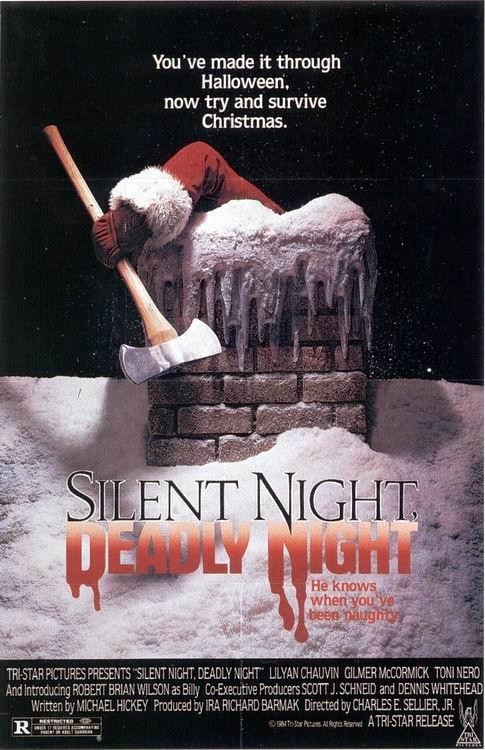 A dozen years ago I wrote two essays showing that the War on Christmas in recent times has in fact been conducted by Jews out of their historic hatred of Christ, Christians, and European Whites. Recently, I was a guest on Guide to Kulchur, hosted by Frodi Midjord, and we talked about my 2008 essays “Merry Christmas Movies … NOT!” Today I will update those essays.
A dozen years ago I wrote two essays showing that the War on Christmas in recent times has in fact been conducted by Jews out of their historic hatred of Christ, Christians, and European Whites. Recently, I was a guest on Guide to Kulchur, hosted by Frodi Midjord, and we talked about my 2008 essays “Merry Christmas Movies … NOT!” Today I will update those essays.
Jewish columnist Burt Prelutsky bluntly explained my point in his 2004 column “The Jewish Grinch who Stole Christmas,” beginning with “I never thought I’d live to see the day that Christmas would become a dirty word. … Schools are being forced to replace ‘Christmas vacation’ with ‘winter break’ in their printed schedules.” We all know about that, as a whole generation now has become inured to the horrid greeting, “Happy Holidays.”
“How is it, one well might ask, that in a Christian nation this is happening?” asks Prelutsky. In plain English, he spells it out: “I blame my fellow Jews. When it comes to pushing the multicultural, anti-Christian agenda, you find Jewish judges, Jewish journalists, and the American Civil Liberties Union, at the forefront. . . . But the dirty little secret in America is that anti-Semitism is no longer a problem in society — it’s been replaced by a rampant anti- Christianity.” Amen to that, brother.
Next, we turn to Prelutsky’s fellow Jew, Neil Gabler, an expert on Hollywood whose 1988 book title alone tells us all we need to know: An Empire of Their Own: How the Jews Invented Hollywood. Prelutsky didn’t mention Hollywood in his War on Christmas, so I’ll show how Jews are busy there destroying the spirit and intent of that sacred day for Christians. It’s not pretty, either.
This undermining of the Christian meaning of Christmas began early in America, before and during World War II, but it was subtle enough that few goyim noticed, let alone objected. We had, for instance, the huge hit “White Christmas,” written by Irving Berlin, born ביילין ישראל, or “Israel Beilin” for those who don’t read Hebrew.
Mark Steyn (“A Triumph of Miscegenation,” The Spectator, December 17/24, 1994) light-heartedly described how Jews created a gradual division between religious and secular Christmas symbols, making America a society where “Jesus, Mary and Joseph are for home and for church; Santa, Rudolph and Frosty the Snowman — the great secular trinity — are for everybody.” For instance, “Rudolph the Red-nosed Reindeer,” was first a book created by Robert May in 1939 and a decade later inspired his brother-in-law Johnny Marks to write a song about Rudolph. Both men were Jewish.
Also Jewish were Jule Styne and Sammy Cahn, who together wrote the lyrics
Oh, the weather outside is frightful
But the fire is so delightful
And since we’ve no place to go
Let it snow! Let it snow! Let it snow!
Of course this “compromise” to take Christ out of popular culture was a great victory for Jews, for it allowed the hostility many Jews felt toward a Christian majority to find vent without the Gentiles really noticing. Novelist Philip Roth, however, knew exactly what it meant:
The radio was playing ‘Easter Parade’ and I thought, But this is Jewish genius on a par with the Ten Commandments. God gave Moses the Ten Commandments and then He gave to Irving Berlin ‘Easter Parade’ and ‘White Christmas.’ The two holidays that celebrate the divinity of Christ — the divinity that’s the very heart of the Jewish rejection of Christianity — and what does Irving Berlin brilliantly do? He de-Christs them both! Easter he turns into a fashion show and Christmas into a holiday about snow. Gone is the gore and the murder of Christ — down with the crucifix and up with the bonnet! He turns their religion into schlock. But nicely!
Nicely! So nicely the goyim don’t even know what hit ’em. They love it. Everybody loves it. The Jews especially. Jews loathe Jesus.
In the context of the times, however, such songs were not obviously anti-Christian. It was not until Jews achieved cultural hegemony in the late 1960s that the underlying sentiment of hostility toward Christians in America came out into the open, led first and foremost by the just-mentioned Philip Roth, whose 1969 blockbuster novel Portnoy’s Complaint was shockingly candid about the prevalence of Jewish hatred toward Gentiles. Somehow, few Gentiles (Whites) of the time even noticed, so in an important sense the book served as a litmus test for how explicit Jews in America could be about their contempt for goyim. And that contempt turned out to be immense. Still, it took time for this hostility to emerge, then dominate.
Obviously, “Happy Holidays” and “Season’s Greetings” were not always ubiquitous during the month of December, nor were real Christmas songs in any way unwelcome. Quite the contrary. Criticism of Christmas was not easily tolerated. For instance, back in 1952, George S. Kaufman appeared on a popular television show one week before Christmas and was asked what he wanted for the holiday. He replied, “Let’s make this one program on which no one sings ‘Silent Night.'” The response from the audience (largely Gentile, one would presume) was fast and furious: Kaufman was removed from the show and exiled from the TV screen for a year thereafter.

Fast-forward to 1982 and the popular Saturday Night Live Show featured a skit called “Merry Christmas, Dammit!” This skit portrayed the relationship between Donny and Marie Osmond, two non-Jewish sibling pop singers, as incestuous, and the Virgin Mary was described as “that virgin chick” in a jazzed-up version of “Silent Night.” Eddie Murphy — in his popular “Gumby” guise — read a children’s story in which Santa tears out the lungs of one of his elves because the elf asked for a sip of Santa’s hot chocolate. He ends the skit by saying “And to everyone out there — a Merry Christmas! And to my producer, my director, my manager, and my lawyer — Happy Hanukkah, boys!” Obviously, sensibilities had changed by then, and the people calling the shots were Jews.
Again, beginning in 1969 and the huge success of Roth’s Portnoy’s Complaint, with its lusty protagonist prone to masturbating into pieces of raw liver, we eventually witness a parade of degraded images of excretory functions paired with Christmas imagery. Thus, we had Jewish illustrator Art Spiegelman trying to get this drawing onto the cover of The New Yorker:
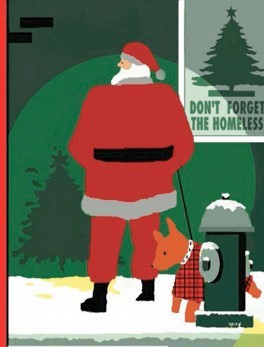
Sadly, the drawing was rejected, but Spiegelman and the art editor of The New Yorker (his wife) were able to use the image as their 1993 Christmas card instead. And The New Yorker did run Spiegelman’s Easter cover picture of the Easter Bunny being crucified, but that’s another story.
Jump ahead four years and Santa urinating is upstaged by South Park’s “Mr. Hankey, the Christmas Poo.” In this recurrent theme, Mr. Hankey “emerges from the toilet bowl on Christmas Eve and brings presents to good boys and girls whose diets have been high in fiber. He is especially close to Kyle [a Jewish boy], consoling him during his Christmas-Hanukkah depression and generally appears to help the boys out with something or gives them advice.”

Mr. Hankey was introduced in a 1997 episode that showed the young Kyle brushing his teeth. Mr. Hankey, wearing a Santa hat, jumps out of the toilet bowl and sings a song about Santa and Christmas. The starkest comment in the scene comes when this animated feces writes “Noel” in excrement on the mirror.
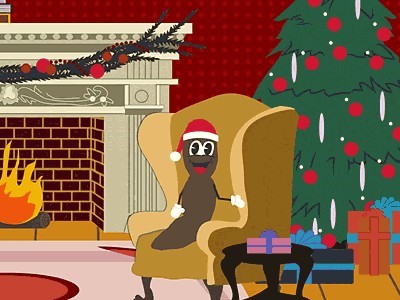
Two years later, the more extensive Mr. Hankey version was released as Mr. Hankey’s Christmas Classics. (A parallel CD of the songs includes the delightful “Merry Fucking Christmas”). Here Mr. Hankey besmirches the faces of children singing Christmas songs. He then introduces us to the next scene, “Christmastime in Hell,” where Hitler is shown crying over his Christmas tree. Later, when Jesus and Santa sing a duet, Santa gets miffed that there are far more songs about Jesus than about him, so he leaves the stage. When Jesus implores him to return, Santa speaks the cheery words, “Aw, fuck you, Jesus!”
This episode is a parody of the Charlie Brown Christmas Special in which everyone yells out “Merry Christmas, Charlie Brown!” only after Charlie has realized the true meaning of Christmas — which has Christ at its center. In the South Park version, the characters wish the Jewish boy Kyle a Merry Christmas only after he has taught everyone, through Mr. Hankey the Christmas Poo, that Christmas and Christianity are shit.
I feel compelled here to provide a slightly tangential account of Jewish attitudes toward Christmas, fairly tinged with scatological associations, in order to show that the above representations are not simply generically juvenile creations. To do this, we must scurry over to the Israeli site Haaretz for the skinny – For them, it’s wholly unholy:
Christmas Eve is one of the few occasions when Hasidim refrain from Torah study, do not conduct weddings or go to the mikveh [ritual bath for women]. But they do play chess and work on their bills.
On Christmas Eve, known in Jewish circles as Nitel Night, the klipot (shells) are in total control. The klipot are parasitical evil forces that attach themselves to the forces of good.
According to kabbala (Jewish mysticism), on the night on which “that man” — a Jewish euphemism for Jesus — was born, not even a trace of holiness is present and the klipot exploit every act of holiness for their own purposes.
For this reason, Nitel Night, from nightfall to midnight, is one of the few occasions when Hasidim refrain from Torah study. On this horrific night, they neither conduct weddings nor do they go to the mikveh (ritual bath). An entire folkloric literature has developed around the unusual recreational activities of Nitel Night.
Oh, there’s the usual disclaimer that not all Jews follow this custom, but in three decades of research on Jews I’ve found that it’s simply a truism that Jews have an exceedingly negative view of Jesus, Mary, Christians, and Christmas. No wonder so many spit when passing a church . . . or even spit on Christians themselves in Israel.
But in the Haaretz story, this passage about Kabbalistic toilet paper really stood out:
The Knesset correspondent of the ultra-Orthodox newspaper Hamodia, Zvi Rosen, relates that celebrated Hasidic admorim (sect leaders) would cut a year’s supply of toilet paper for Sabbath use (to avoid tearing toilet paper on Sabbath) on this night. Actually, this disrespectful act has profound kabbalistic significance, because kabbalistic literature extensively discusses Christianity as waste material excreted from the body of the Jewish people.
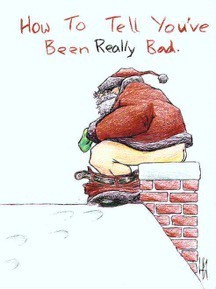
Honestly, I couldn’t make this stuff up. And get this: One of their commandments recommends that they attempt procreation on Friday night, which is a holy time. “Yet on Nitel Night, which has no holiness, it is customary to refrain from observing the commandment, because of the fear that a Jewish child conceived on Jesus’ birthday could become an apostate.”
Gentiles have no idea what they are dealing with when we talk about Jewish ascendency in the creation and control of Western culture. Often, I too simply shake my head.
When I wrote these essays in 2008, I included plenty of links, but a surprising number of them are now dead, so I’ve had to learn to use the Wayback Machine. Still, some sources are beyond locating now, such as Christmas movie reviews by a Jewish individual named Austin Pearl. My links were rock solid in 2008, so I’m going to continue to use Pearl’s Jewish views because they tie together many of the films discussed here.
Pearl gleefully explained his motive for collecting anti-Christmas films: “It’s my wanting to recognize things that are deliberately anti-Christmas. It’s my wanting to take a big you know what on everyone’s Christmas spirit. . . . Each one of them is so anti-Christmas that I want to share them with the world, thereby forcing everyone to realize how liberating it is to rip off the Christmas mind control device and have some laughs in the process.” There is the scatological reference again — “wanting to take a big you know what on everyone’s Christmas spirit.” Clearly we are seeing a pattern emerge.
Humor such as in South Park is juvenile, but in reality it rests upon a long Jewish tradition of hatred of and disrespect for Christmas. Still, it doesn’t really rise to the level of successful cultural subversion. For that, we need to consider a raft of anti- Christmas films. To put this into its proper context, let’s consider the broader circumstances of the modern era. As Kevin MacDonald demonstrates in The Culture of Critique, “The Judaization of the West means that the peoples who created the culture and traditions of the West have been made to feel deeply ashamed of their own history — surely the prelude to their demise as a culture and as a people.” To being ashamed, we can now add that we Western people — Whites — have been subjected to subliminal conditioning that tries to associate positive Christmas symbols with terrifying experiences, thus subverting the beauty and even worship attached to traditional Christmas images, songs, etc.
While Hollywood Christmas movies were almost exclusively positive in the past, like Christmas songs, they have been stripped of religious meaning — and then turned into visual horror shows. Perhaps the best example of this is Silent Night, Deadly Night.
This is a 1984 slasher film that begins with a young boy named Billy witnessing the murder of his parents by a man dressed as Santa Claus. Billy ends up at St. Mary’s Orphanage, where he is beaten by Mother Superior. Later, morphing memories of his punishment at her hands with images of Santa, Billy grows up to become a killer teenage Santa. At work, for example, he strangles a co-worker with Christmas lights and then dispatches the girl with whom the co-worker was having sex.
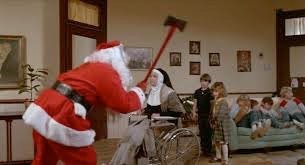
After a string of other Santa murders, Billy returns to the orphanage, with the police hot in pursuit. Tragically, they shoot and kill Father O’Brien, a deaf priest dressed as Santa. Sneaking into the orphanage, Billy, dressed as Santa, swings his ax at Mother Superior, but a policeman shoots him down. Imparting his central message, Billy assures viewers, “You’re safe now … Santa Claus… is gone.” Not exactly a happy message at Christmastime.
In 1984, such imagery was still able to rile the public. Siskel and Ebert condemned the film, going “so far as to read the film’s production credits on air, saying ‘shame, shame’ after each one.” Angry mothers protested the movie around the nation, and TriStars Pictures, its distributor, quickly ceased advertising the film.
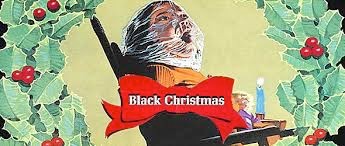
Silent Night, Deadly Night did have antecedents. Black Christmas was a 1974 movie set in a sorority house during Christmas break. A maniac is making calls from within the house, killing the coeds one by one. The movie also takes every opportunity to pair beloved Christmas songs with chilling scenes, a phenomenon that was later repeated in Gremlins, as we will see.
Another, Christmas Evil (1980), features a delusional Santa stand-in who murders three church-goers in front of a church. (He stabbed one man in the eye with a toy.) Later, while wearing a ragged Santa outfit and being chased by an angry mob, our main character drives his van off a bridge, imagining himself to be Santa in his flying sleigh.
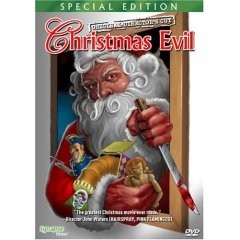
Austin Pearl, our Jewish reviewer, approvingly wrote, “Christmas Evil ruins Christmas unlike any other movie.” In particular, this reviewer liked “all the vividly disturbing images of Santa sprinkled throughout the movie.”
It’s no surprise that Pearl also liked the 2003 Billy Bob Thorton film Bad Santa, which was a concerted ethnic effort to trash Christmas. Jewish director Terry Zwigoff made the film under producers Ethan and Joel Coen for the Disney subsidiary Miramax, run by two Jewish brothers, Bob and the notorious Harvey Weinstein. Billy Bob Thornton starred as the bad Santa of the title, going about his life boozing and swearing with abandon. At one point he has anal sex with an overweight woman in a changing room, while elsewhere he goes to a mall drunk and destroys a reindeer display in a drunken rage. Ho ho ho.
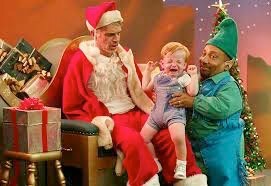
Near the end of this dark film, he is shot by a group of policemen but survives. Despite his obvious guilt in numerous crimes, he is pardoned because “the Phoenix police department [thought that] shooting an unarmed Santa Claus in front of children was more fucked up than Rodney King.”
According to Wikipedia, critics generally liked the film, with one describing it as an “evil twin” of “Miracle on 34th Street,” the inspirational Christmas classic. According to reviewers’ consensus on Rotten Tomotoes, it’s “A gloriously rude and gleefully offensive comedy, Bad Santa isn’t for everyone, but grinches will find it uproariously funny.” No wonder Austin Pearl wrote glowingly that “Bad Santa is perhaps the most subversive, offensive Christmas movie ever made — with Thornton as a truly despicable character who, for once, does not receive a total personality transplant by the movie’s end.”
Director Zwigoff intended this film for impressionable teenagers, the vast majority of whom are, one would assume, Christian.
When asked if he thought the film would do well, Zwigoff answered, “I think it might. Every teenager in America is dying to see this film. Though they won’t be able to get in unless they have a very open-minded parent.” Clearly he was aware of the film’s subversive content.
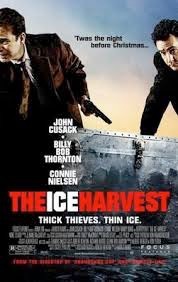
Two years later came another Jewish-directed anti-Christmas movie. The Ice Harvest, Harold Ramis’s “grisly black comedy/film-noir,” sees Billy Bob Thornton return to a mayhem-filled Christmas. One reviewer intoned that The Ice Harvest “is a must-see for fans . . . in the mood to see one of the worst Christmas Eves in the history of cinema.” Roger Ebert (page has been taken down) was also impressed. “I liked the movie for the quirky way it pursues humor through the drifts of greed, lust, booze, betrayal and spectacularly complicated ways to die.” In other words, Hollywood’s version of Merry Christmas stuff.
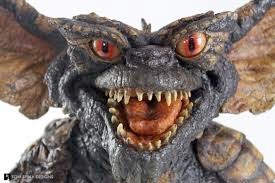
Gremlins
In my personal view, the most unsettling Christmas movie was the original Gremlins (1984). Though directed by Joe Dante, Steven Spielberg’s production company Amblin Entertainment released it. TIME magazine characterized the film as being “developed and ‘presented'” by Spielberg and being one of his “children too.” Stylistically, too, this film is completely Spielbergian, beginning with a typical suburban paradise. Snow is on the ground as local residents prepare for Christmas.
The drama begins when protagonist Billy receives a cute “mogwai” from his inventor father, but the creature spawns siblings that are far from full of holiday cheer. On the contrary, they bring violence, mayhem, and death to this otherwise happy time of year. Their mischief is methodically paired with normally positive symbols of Christmas. For instance, when Billy’s mom is home alone making Christmas cookies and listening to Christmas music, she is attacked by a squad of ghoulish gremlins with murder on their minds. After stabbing one through the heart, she dispatches another with a deft push of the blender switch, turning the previously Christmas-cookie-aroma-filled kitchen into a bloodbath.
More blood is added when a gremlin foolishly hides in the microwave. A few minutes on high power and his head delightfully explodes. Retreating to the living room, the mother is literally attacked by the Christmas tree, which is full of gremlins. This conflation of joyful Christian symbols with diabolical evil is a central device to the whole movie.

Another example comes when the police pass by Billy’s neighbor’s house and are greeted by the neighbor, dressed as Santa Claus, running about helplessly as gremlins eat into his brain. Next, Christmas-caroling gremlins arrive at grouchy old Miss Deagle’s door, only to send her flying out the second-floor window of her house in a malfunctioning motorized chair.
I call this movie “most unsettling” because I remember when it came out, and the trailers and ads were specifically aimed at children — young children, as I recall, 4–8 years old. I also recall many tales of parents angrily leading their shrieking children out of theaters because families had been led to believe this was a fun Christmas movie. Tell me if you think the following is fun.
In two scenes I thought were totally extraneous, protagonists Billy and his girlfriend Kate pass a group of Christmas carolers singing “Silent Night,” when Kate suddenly and soberly states that Christmas is a time when “a lot of people get really depressed. . . . While everybody else is opening up their presents, they’re opening up their wrists. It’s true. The suicide rate is always the highest around the holidays.” When she volunteers that she doesn’t celebrate Christmas, Billy asks, “What, are you Hindu or something?” Historically, the non-Christian group in America with mixed feelings toward Christmas is not Hindus, but Jews. Here the mask is in place but the true message is easily discernible. It is Jews who hate Christmas.
Much later in the movie, after the gremlins have wreaked havoc on Kingston Falls, Kate launches into a startling horror story about Christmas, one that seems completely gratuitous since it is independent of the blood-thirsty gremlin theme. Surveying the rubble left by the marauding gremlins, Kate relates how she now has another reason to hate Christmas. It seems that when she was nine, she and her mother were decorating the tree on Christmas Eve, waiting for her father to come home from the office. They waited, but he never came.
Then, four or five days later, as the temperature dropped, Kate went to make a fire. “And that’s when I noticed the smell.” Thinking it was a dead cat or bird, they called the fire department to clean it out, but instead “they pulled out my father. He was dressed in a Santa Claus suit. He’d been climbing down the chimney on Christmas Eve, his arms loaded with presents. He was going to surprise us. He slipped and broke his neck, died instantly. And that’s how I found out there was no Santa Claus.”
Now that you’ve read my account of Gremlins, go back and watch it again. Note the systematic pairing of Christmas songs with things negative, a Christmas tree with violence, Christmas carols with monsters. And of course, not the slightest hint whatsoever that Christmas has anything to do with a religious holiday celebrating a divinity that Christians traditionally believe to be God.
There’s actually a dizzying array of Christmas films available—over 100 since 2010, including 26 horror films—and too many to review here. Not all Christmas movies are subversive—Hollywood is well aware that there is money in appealing to particular audiences, such as viewers of Hallmark or the Lifetime Movie Network. One such is the popular Elf (2003), by screenwriter David Berenbaum and director Jonathan Favreau, who is half Jewish, with Ed Asner starred as Santa, and James Caan as the elf’s biological father. I invite readers to comment about this film and, because of the glut of films, I’ll need to do that with some other Christmas films as well.
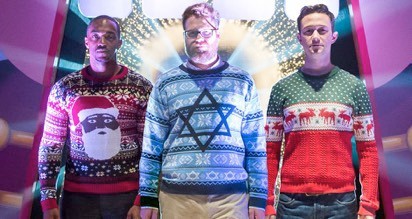
A recent film that looked highly promising as far as my thesis goes is The Night Before (2015) starring Jewish actors Seth Rogen and Joseph Gordon-Levitt, along with Anthony Mackie, who is Black. (This lack of White males fits into my recent photo essay showing how in 2020 Whites males have been almost completely airbrushed out of commercials.) Further, the film is “a successful collaboration between Seth Rogen and Evan Goldberg”; the director is Jonathan Levine.
More to the point, reviewer Ben Kendrick strongly suggests that this movie also shows great disrespect for Christmas. The Night Before is “irreverent,” “nor is it a Christmas movie for all audiences” (such as believing Christians, for example?). The film blends “stoner hijinks and holiday spirit.” It is a “raunchy comedy set against a holiday backdrop,” and, in a key description, Kendrick admits that “It’s a surprisingly subversive tale, playing off Christmas movie tropes in unique (and often hilarious) ways.” Again, I need to ask readers to see how this Jewish-inflected film approaches traditional Christmas.
Other films that caught my eye were Black Christmas (2006), a “Canadian-American slasher film,” Four Christmases (2008), The Christmas Chronicles (2018) and Last Christmas (2019). Comments on them are also welcome.
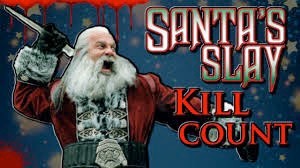
Santa’s Slay
I put aside all of these films, however, when I hit pay-dirt yesterday with the film Santa’s Slay (2005). I’m going to start with Wikipedia’s description:
Santa’s Slay is a 2005 Canadian American Christmas slasher comedy film that stars professional wrestler Bill Goldberg as Santa Claus. The film was written and directed by David Steiman, a former assistant to [Jewish] Brett Ratner; Ratner served as a producer….
On Christmas Eve, the Mason family (played by a cast of all Jewish celebrities in bit roles) is bickering about their wealth and material possessions while eating Christmas dinner when Santa Claus (Bill Goldberg, also Jewish) comes down the chimney and kills them all in various graphic displays of Christmas-themed violence, such as drowning the matriarch Virginia (Fran Drescher) in eggnog, using the star atop a Christmas tree as a ninja star and stabbing the patriarch’s hands to the table with silverware and suffocating him by stuffing a leg of turkey in his mouth. Riding on his sleigh driven by his “hell-deer,” the Buffalo-like Beast, Santa arrives at Hell Township and decimates the locals in various holiday-themed ways. In one of his kills, Santa slaughters the occupants of a local strip club, frequented by Pastor Timmons (Dave Thomas), a crooked minister, who manages to survive the massacre.
Yes, this “gift” was dropped right in my lap as I perused Jewish-created anti-Christmas films. You have to watch this selection of scenes to believe it.
Typical goys are celebrating a traditional Christmas scene with carols and a creche. “Santa” on his sleigh comes through, beheading the statue of Joseph. The actual opening, however, begins with a beautiful rendition of “Joy to The World” against a shot of a well-decorated millionaire’s home, and then zooms into the well-appointed dining room of a large “Gentile” family.
James Caan plays the patriarch, and the whole skit is reminiscent of the typical Hollywood ploy of mocking the goyim, as in the old Caddyshack series. Childishly tasteless and gauche, Caan criticizes the dry turkey, mock praying, “Let it be tender and moist,” to which his wife (played by Fran Drescher) retorts, “Yeah, moist, it’s called foreplay.” Then one family member sodomizes his wife under the table. Lots of laughs. Soon, however, we get bulked-up former wrestler Bill Goldberg as a Viking Santa coming down and through the chimney for some Christmas murder.
More goy mocking comes a little later when Mrs. “Talbot” bullies Jewish Mr. Green at his deli, insisting that he use “Merry Christmas” rather than “Happy Holidays.” Immediately after this, the miserly biddy is driven off the road by Goldberg in his sleigh, and she dies in a fiery inferno. Ah, revenge.
Surprisingly, however, the attack on Christians doesn’t go much beyond that. Yes, later two Gentile boys dressed in red and green pajamas ask their parents if they “can open our mother f**king presents now?” When they open the presents, there are explosions and the boys’ heads are blown off, to which goy Grandma slowly replies “F**k.” In the milieu of 2005, this does not rise to the level of high offense, let alone blasphemy. In addition, Jesus Christ is never mentioned, let alone attacked.
I can’t explain why this is. By 2005, Jews held such a lock on American culture that they could pretty much do what they wanted, as we saw in Quentin Tarantino’s 2009 film Inglourious Basterds. Though director Tarantino is not Jewish, Eli Roth is, and as Sergeant Donny “The Bear Jew” Donowitz, he executes Nazis with his baseball bat. Roth famously said that such filmic revenge amounted to “almost a deep sexual satisfaction of wanting to beat Nazis to death, an orgasmic feeling. My character gets to beat Nazis to death. That’s something I could watch all day.” In addition, Lawrence Bender, one of the producers, told Tarantino that “As your producing partner, I thank you, and as a member of the Jewish tribe, I thank you, motherf**ker, because this movie is a f**king Jewish wet dream.”
Screenwriter and director David Steiman, et al. could have accomplished something similar with Santa’s Slay but for some reason they didn’t even come close. Instead, we ended up with a stupidly juvenile and unprofessional film that was a real chore to watch. Given the coarse level our society has fallen to this century, though, it is hardly surprising that untalented reviewers could write that Santa’s Slay was “simultaneously vulgar and wholesome, stupid and satirical, violent and lighthearted.” Or that “overall it is just a fun, brainless movie that has a ton of violence in it.” Another wrote that “Admittedly, the film doesn’t quite keep up the relentless pace the entire time, but it’s mostly one hell of a slay ride, full of cheesy dialogue, colorful characters, and plenty of laughs.”
“Plenty of laughs.” You can do that with Christmas, of course, but try it with a comedy about the Prophet Muhammad … or the Holocaust. You know, make a “brainless movie” with “colorful characters, and plenty of laughs” about Auschwitz or something. But plan to start looking for a new job the next day.
In any case, Santa’s Slay hardly bothered me, unlike the way Gremlins did. Though Santa’s Slay is clearly patterned on Gremlins, beginning with the use of the song “Christmas (Baby, Please Come Home)” at the opening of both films, it’s a different film (perhaps because the filmmakers were untalented).
Throughout Santa’s Slay the mood mimics Gremlins, plus we have the same type of teenage protagonists, along with a quirky inventor in the family.
Beyond that, however, Santa’s Slay doesn’t come close to the subversion of the Christmas spirit the way Gremlins did. What it did, oddly, was begin to subvert Jews themselves, which really surprised me.
Here I’m going to go out on a limb and attempt a reading of Santa’s Slay worthy of Jay Dyer or Mark Brahmin. While I’ve never really understood Michael Hoffman’s “Revelation of the Method,” I sort of get that it means producers of messages deliberately reveal who they are and what they are doing. And in watching Santa’s Slay, I kept asking myself “Are the Jews making this movie revealing themselves as satanic”?
Yes, I know at this point you are going to cry “WHAT?!!!” But consider that when the credits begin to roll, we are treated to the wordplay of seeing the title first as Satan’s Slay then morph into Santa’s Slay. And throughout Goldberg certainly plays a satanic Santa. What really cements this view, however, is the fact that a central part of the story refers to two virgin births: that of Christ and that of Satan, with Santa Claus being the resulting issue.
Finally, though Goldberg’s Santa wreaks massive havoc and leaves a long trail of people quite dead, in the end a (Christian) angel prevails, and the Gentile teenage couple happily escapes, while satanic Santa is again remanded to the control of the angel. Jews had free rein in this film, yet it turned out to empower Christian Whites. Curious.
And with that happy turn of events, I’ll end this discussion by giving readers a heartwarming review of the 2015 Hallmark film, ‘Tis the Season for Love, which I called “a pro-White, pro-natal TV movie.”
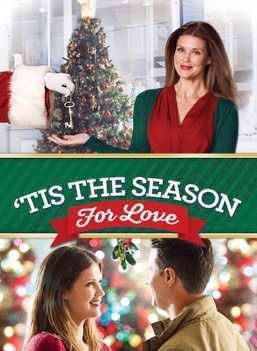
Merry Christmas. I look forward to reader comments on modern Christmas films.
https://www.theoccidentalobserver.net/2020/12/23/the-war-on-christmas-updated/